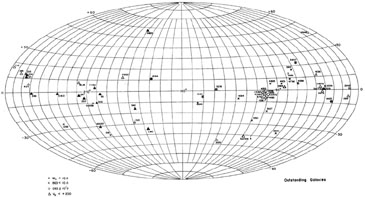


Thirty years ago galaxies were generally regarded as primarily distributed in a so-called general field, i.e., more or less isolated in space, with only a small minority in occasional groups or clusters. More recently there has been some speculation that perhaps the opposite is true and that all galaxies are clustered (even if some stochastic models include ``clusters'' having n = 1 member!) Holmberg (1940) has counted apparent companions of a selected sample of G.C. objects (10 < m < 13) in the Reinmuth survey; after statistical correction for optical companions and incompleteness he derived the following relative frequencies:
| Multiplicity m | 1 | 2 | 3 | 4 | 5 | 6 | 7 |
| Frequency (%) f | 47 | 24 | 15 | 7 | 4 | (2) | (1) |
| f = 2-m | 50 | 25 | 12.5 | 6.25 | 3.12 | 1.56 | 0.78. |
Thus 47 percent of all galaxies of 10 < m < 13 appear to be single,
24 percent are members of pairs, 15 percent of triplets, etc. It is
perhaps more than a passing curiosity that the observed frequencies
are well approximated by f(m) = 2-m which suggests
that for all m  8,
8,
 f = 1.3 percent. Statistics
based on apparent magnitudes refer to an
indefinite volume of space, and frequencies depend very much on the
operational definition of a group. Holmberg's counts refer mainly to
dense groups and multiplets and include only a small fraction of the
loose groups considered in this chapter.
f = 1.3 percent. Statistics
based on apparent magnitudes refer to an
indefinite volume of space, and frequencies depend very much on the
operational definition of a group. Holmberg's counts refer mainly to
dense groups and multiplets and include only a small fraction of the
loose groups considered in this chapter.
Ideally counts should refer to a specified volume of space, but this is not practical and even then the problem of dwarf galaxies (how far down the luminosity function should one place the cutoff?) will complicate matters.
The present data on nearby groups may nevertheless help to answer the simpler question: Are there isolated galaxies? Figure 7 shows the distribution in supergalactic coordinates of all galaxies in the Reference Catalogue which are either brighter than B(0) = 10.0 (or corrected Shapley-Ames magnitude mc), or larger than D(0) = 10'.0 or have corrected radial velocities V0 < +200 km s-1 (adding IC 10 and IC 342 with allowance for absorption). Out of the 60 galaxies in this objectively selected sample, only eight have not been associated with one of the 55 nearby groups, viz., NGC 0404, NGC 1313, NGC 2903, NGC 3109, NGC 3521, NGC 6744, NGC 6946, and IC 5152. In addition there is a possibility that a few galaxies, such as NGC 1316, NGC 4594, NGC 4826, are not really members of the groups (For I, Vir Y, CVn I) to which they have been tentatively assigned. Furthermore, the reality of the NGC 5128 chain as a physical unit may be questionable; but then it is difficult to know where to stop in this ``dismemberment'' of loose groups, and the logical outcome of an overconservative attitude would be to exclude from consideration all but a few rich clusters and dense groups (the Local Group itself would not hold too well under this critical approach). By the definitions set up in Section 1 we must conclude that not more than 8 to 14 of the 60, i.e., 13 to 23 percent, of the ``outstanding'' nearby galaxies are isolated in space. This is only one-quarter to one-half of Holmberg's estimate.

|
Figure 7. Apparent distribution of outstanding galaxies in supergalactic coordinates. |
On the other hand, several of the eight supposedly isolated galaxies might upon further investigation turn out to be members of some of the nearer groups; in particular NGC 0404, NGC 3109, and IC 5152 should be examined for possible membership in the Local Group. Other (more remote) possibilities are NGC 1569, IC 0342, and perhaps some heavily obscured systems as yet unrecognized. For example, IC 0010, although long suspected, was only recently established as a Local Group member (Roberts 1962; de Vaucouleurs and Ables 1965). If this were the case, the frequency of isolated galaxies might be reduced to 10 percent or less, again depending somewhat on how strictly or loosely a group is defined. Nevertheless it seems difficult to reduce the frequency to zero; to the writer's knowledge NGC 1313 and NGC 6744 in the southern sky, and probably NGC 2903 and NGC 6946 in the northern sky, are truly isolated galaxies not associated with any nearby group, although both are in the larger Local Supercluster discussed in Section 10.